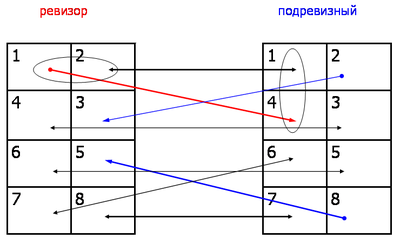Relations of social control (revision)

Asymmetric relations.
Signs of the corresponding functions are different.
Function interactions:(controller↔ controlled): 1 ↔ 4, 2 ↔ 1, 3 ↔ 2, 4 ↔ 3, 5 ↔ 8, 6 ↔ 5, 7 ↔ 6, 8 ↔ 7.
1controller ↔ 4controlled. This influence from the controller's function1 on the function 4 of the controlled is what makes these relations most unconfortable. Even the fact that information from the controller's function 2 comes to the ego block (2controller ↔ 1controlled) of the controlled (not to the superego block as it happens in the conflict relations) does not save the situation and can even worsen it, because the information comes in an "upturned" form (in semantics of different block). For the controlled is natural to perceive information element of his function 1 with other sign and in block with other function, i.e. one can say that the IE field is quite different and the information coming to the function 1 is strange by its "spirit", it is closely connected with the element which corresponds to the function 4 of the controlled and every time, as information is coming to his base function, his pain function gets hurt. From his wievpoint it is a very strange and confusing combination of elements. In his turn, the controller is wondering why such a sensible person (who is so competent in the information element related to his fiunction 2: 2controller ↔ 1controlled) cannot understand very basic things (1controller ↔ 4controlled).
3controller ↔ 2controlled. Relations of the functions 2 and 3 cause no discomfort because the controller's function 3 is normatively correct. The function 2 of the contolled generates up to situation solutions and it can be taken into consideration by the controller provided that the topic related to this information element is interesting for him.
4controller ↔ 3controlled. Information coming from the normative function of the controlled falls onto the one-dimensional function of the controller. The controlled demonstrates his correctness related to this element and the controller might seem a bit inadequate which does not promote their understanding.
5controller ↔ 8controlled. This is the only point which can make controller feel sympathy for his controlled, because he gets suggestive information from the partner's function 8. Regretfully, the id block is not much verballized and is used mostly for individual needs. What does receive the controlled type to please his suggestive function?
6controller ↔ 5controlled Controller's function 6 belongs to the "child block" superid and in this case controller himself is expecting praise and positive feedback. The controller is dimension-wise capable to encourage his partner providing him positive feedback to the function 6: 7controller ↔ 6controlled, but again, contoller's function 7 belongs to the vital track and takes little interest in other people's activities related to this element as long as they don't interfere with him personally.
8controller ↔ 7controlled. Interaction of two high-demensional functions from respective id blocks is neither fruitful nor problematic. In long-term relationships the id functions adapt to each other.
In the final analysis, we have a situation of unequal interaction of two TIMs, in which the controlled TIM has no tool of reciprocal influence to the controller TIM, and the latter is controlling the pain area (function 4) of his partner.